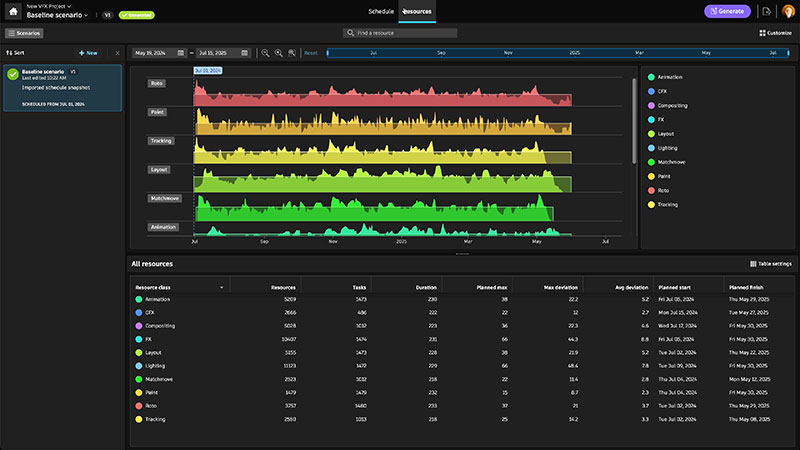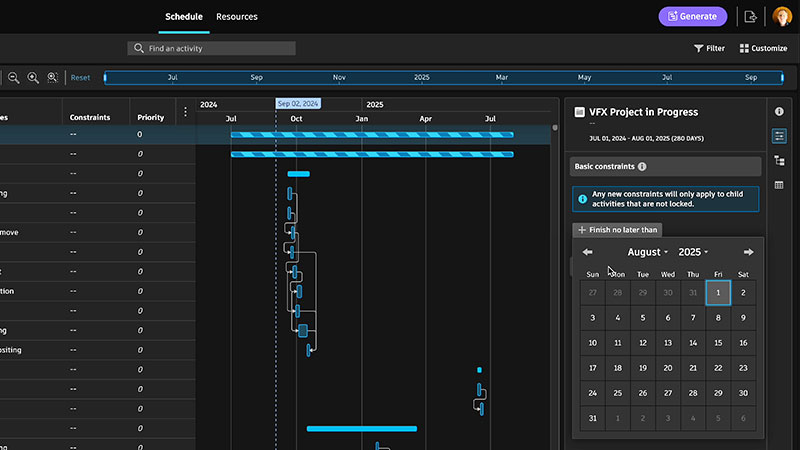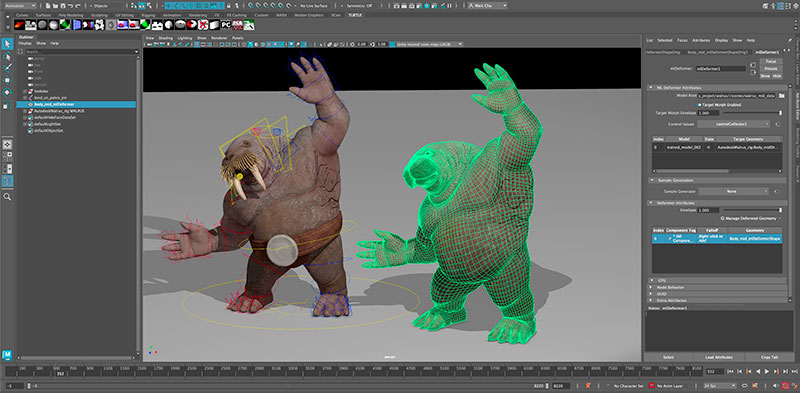Autodesk returned to SIGGRAPH 2024 to show software updates that include generative AI and cloud workflows for 3D animation in Maya, production scheduling and clip retiming in Flame.

Using Flow Generative Scheduling to display a resource view.
Autodesk returned to SIGGRAPH 2024 in July to show software updates that include generative AI and cloud workflows for 3D animation in Maya, production scheduling and clip retiming in Flame.
AI-powered Production Planning
Autodesk Flow Generative Scheduling is made for content creation studios who need to set up dynamic production schedules that can accommodate constantly shifting project variables – like deadlines, budgets and team availability – to keep projects running smoothly. Running on the Autodesk AI engine, Flow Generative Scheduling is accessed through the Flow Production Tracking production management workflow software, Autodesk’s most recent iteration of ShotGrid VFX.
Teams can use Flow Generative Scheduling to compare multiple schedule scenarios, evaluate the tradeoffs between different resource optimisations, and create balanced schedules for complex projects – in less time then has traditionally been needed.
The tools are useful for longer-term work like planning against a deadline for an upcoming project, but also to respond to changes in real time. Flow Generative Scheduling can also help teams make critical decisions faster, and gain the insights needed to deliver their work on time and on budget. Due to its integration into Flow Production Tracking, users can evaluate different scenarios without impacting a live project, and then publish a revised schedule.

AI-powered Flow Generative Scheduling results in production planning workflows that are dynamic. This graph shows a list view with constraints.
3D Character Animation
New AI-powered features for artists are also coming to Autodesk Maya and Flame following Autodesk's recent acquisition of Wonder Dynamics, makers of Wonder Studio. Originally developed as plugins that combine AI with existing tools like Maya and Flame, the software simplifies animating, lighting and composing 3D characters within live-action scenes.
For example, the new ML Deformer in Maya supports animators, VFX artists and games artists working with complex characters. The tool processes complex deformation systems and represents them with a fast, more responsive approximation derived through machine-learning. When characters with a complex deformation system are responding slowly, Maya can be trained to represent that deformation system using ML Deformer. Artists can use this new representation to work more interactively, and then switch back to the original for final polish or render.

Maya ML Deformer increases interactivity when working with complex characters.
Intermediate Frame Interpolation
ML Timewarp is a new mode integrated into Flame that generates an intermediate frame between two frames in a shot, making it possible to retime clips and produce higher quality renders. It also makes more efficient use of a workstation's hardware by avoiding the need for file transfer workflows across multiple tools. If necessary, this new mode can also be queued to render with remote systems via Autodesk Burn.
These updates and others were demonstrated as part of the Autodesk Vision Series educational sessions that Autodesk held at SIGGRAPH 2024 in Denver at the end of July. www.autodesk.com
Sean Young
Editor


